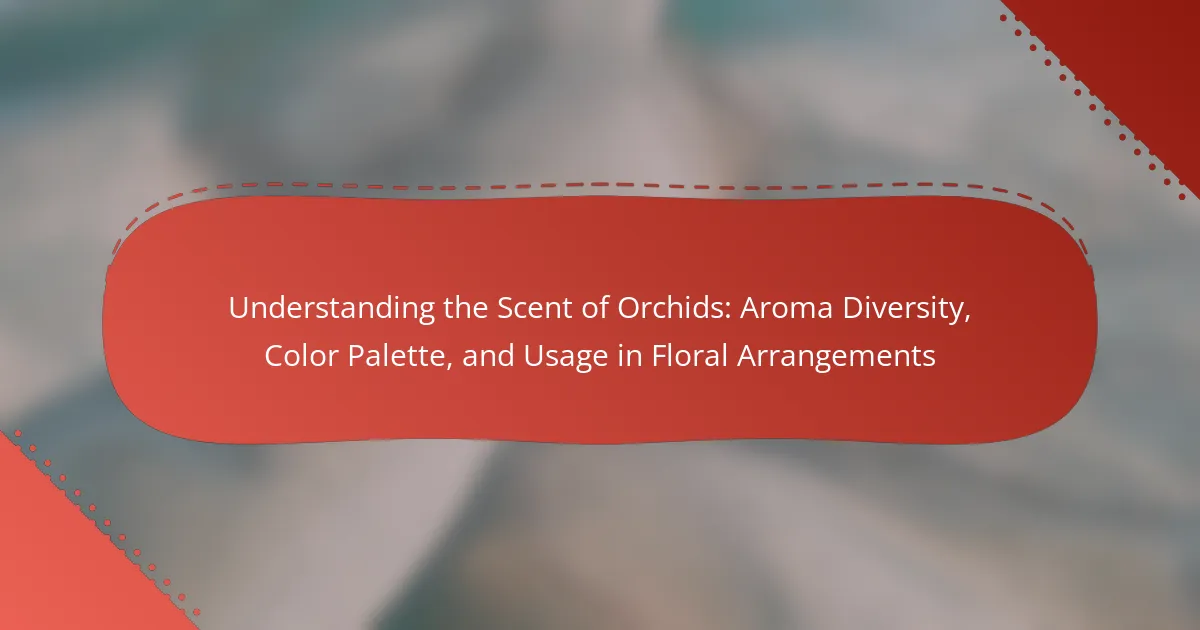
What are the key characteristics of orchid scents?
Orchid scents are diverse and complex. They can range from sweet and fruity to spicy and musky. Many orchids emit pleasant fragrances to attract pollinators. Some species have unique scents that mimic the pheromones of insects. The scent compounds often include terpenes, phenols, and esters. These compounds contribute to the distinct aroma profiles of different orchid species. Studies have shown that specific environmental conditions can influence scent production. For example, light, humidity, and temperature can alter the strength and type of fragrance emitted.
How do different orchid species produce unique aromas?
Different orchid species produce unique aromas through specific volatile organic compounds. These compounds are synthesized in the flowers and vary among species. For instance, some orchids emit terpenes, which contribute to fruity scents. Others may release phenolic compounds, resulting in spicy or clove-like fragrances. The genetic makeup of each species dictates the types and quantities of these compounds produced. Environmental factors also play a role, influencing aroma intensity and composition. Research indicates that pollinator preferences can drive the evolution of these aromatic profiles. Studies have shown that specific scent compounds attract particular pollinators, enhancing reproductive success.
What chemical compounds contribute to the scent of orchids?
Orchids emit their characteristic scent due to various chemical compounds. Key contributors include phenylpropanoids, terpenoids, and aldehydes. Phenylpropanoids, such as eugenol, provide sweet and spicy notes. Terpenoids, like linalool and geraniol, contribute floral and citrus aromas. Aldehydes, including octanal and nonanal, add fresh, fruity scents. These compounds work together to create the diverse aromas associated with different orchid species. Research indicates that the specific combination of these compounds varies widely among orchids, resulting in unique scents. This diversity plays a significant role in attracting pollinators.
How does the environment influence the aroma of orchids?
The environment significantly influences the aroma of orchids. Factors such as temperature, humidity, and light levels affect the production of volatile compounds. Warmer temperatures can enhance scent release, while high humidity often intensifies aroma. Light exposure also plays a role; orchids may produce more fragrant compounds in bright light. Soil composition can impact nutrient availability, influencing the plant’s ability to synthesize aromatic compounds. Research shows that specific environmental conditions can lead to variations in fragrance profiles among different orchid species. For instance, studies indicate that orchids grown in optimal conditions emit stronger scents than those in suboptimal environments.
Why is aroma diversity important in orchids?
Aroma diversity is important in orchids because it enhances pollination success. Different scents attract various pollinators, ensuring effective reproduction. For example, some orchids emit sweet fragrances to lure bees, while others produce musky odors to attract flies. This diversity increases the likelihood of cross-pollination. Cross-pollination contributes to genetic variation, which is crucial for species adaptation. Studies show that orchids with varied aromas have higher pollinator visitation rates. This ultimately supports the survival of orchid species in diverse ecosystems.
What role does aroma play in pollination for orchids?
Aroma plays a crucial role in pollination for orchids by attracting specific pollinators. The scent emitted by orchids can mimic the pheromones of certain insects. This mimicry draws pollinators, such as bees or butterflies, to the flower. Once the pollinator arrives, it inadvertently collects pollen. The pollinator then transfers this pollen to other orchids, facilitating cross-pollination. Research shows that orchids with strong fragrances are often more successful in attracting pollinators. This relationship enhances genetic diversity among orchid populations. Therefore, the aroma is essential for the reproductive success of orchids.
How does aroma diversity affect orchid cultivation and breeding?
Aroma diversity significantly influences orchid cultivation and breeding. Different aromatic compounds can attract specific pollinators. This attraction enhances pollination success, leading to improved seed production. Breeders often select orchids based on desirable fragrance traits. These traits can increase market value and consumer preference. Research shows that certain scents are linked to specific genetic traits in orchids. This connection aids in selective breeding strategies. Additionally, aroma diversity can affect plant health and stress resistance. Overall, diverse aromas play a crucial role in the successful cultivation and breeding of orchids.

What colors are commonly found in orchids?
Orchids are commonly found in a variety of colors. These include white, pink, purple, yellow, and orange. Some species exhibit intricate patterns and combinations of these colors. For instance, the Phalaenopsis orchid is often seen in shades of white and pink. The Cattleya orchid typically showcases vibrant purple hues. Additionally, orchids can display rare colors like blue and green. These colors contribute to their appeal in floral arrangements. Their diverse color palette is a key characteristic of the orchid family.
How do color variations impact the perception of orchid scents?
Color variations in orchids influence the perception of their scents. Different colors can evoke distinct emotional responses and associations. For instance, warmer colors like red and orange are often linked to sweeter, more intense scents. In contrast, cooler colors such as blue and purple may be perceived as having lighter, more subtle aromas. Research indicates that color can affect human psychology, altering how scents are interpreted. Studies show that individuals associate specific colors with particular scent profiles, impacting their overall experience. This interplay between color and scent is significant in floral arrangements, as it enhances the aesthetic and olfactory appeal.
What are the most popular colors of orchids and their significance?
The most popular colors of orchids include purple, white, yellow, and pink. Purple orchids symbolize admiration, respect, and dignity. White orchids represent purity, elegance, and innocence. Yellow orchids convey friendship, joy, and new beginnings. Pink orchids are associated with love, grace, and femininity. Each color carries distinct meanings, often influencing their selection for various occasions. For instance, purple orchids are frequently chosen for formal events. White orchids are commonly used in weddings due to their associations with purity.
How do color and scent work together in attracting pollinators?
Color and scent work together in attracting pollinators by creating a synergistic effect that enhances visibility and olfactory appeal. Bright colors signal the presence of nectar, which draws in pollinators visually. Scent compounds, often produced in specific floral structures, provide additional cues for pollinators searching for food. Research shows that many pollinators, like bees, are particularly sensitive to certain color wavelengths. For instance, bees are attracted to blue and yellow flowers. Simultaneously, the scent of flowers can influence pollinator behavior by guiding them to the flower’s location. Studies indicate that floral scents can enhance the foraging efficiency of pollinators. This combination of visual and olfactory signals increases the likelihood of successful pollination.
What is the relationship between color and fragrance in orchids?
The relationship between color and fragrance in orchids is significant. Different colors in orchids often correlate with specific fragrance profiles. For example, brightly colored orchids tend to attract pollinators with sweet scents. In contrast, darker colored orchids may have more subtle or musky fragrances. Research indicates that these traits evolved to enhance pollination efficiency. Pollinators are drawn to vivid colors and pleasant aromas, leading to successful reproduction. Studies show that the color and scent combination can influence pollinator behavior and preferences. Thus, the interplay between color and fragrance plays a crucial role in the survival and propagation of orchid species.
How can color variations indicate different scent profiles in orchids?
Color variations in orchids can indicate different scent profiles due to the correlation between pigmentation and volatile compounds. Specific pigments, such as anthocyanins, can influence the production of fragrant compounds. For example, darker-colored orchids often produce stronger scents, while lighter varieties may have subtler aromas. Research shows that the presence of certain colors can attract specific pollinators, which may be linked to scent intensity. Additionally, the genetic makeup of an orchid affects both its color and fragrance profile. This relationship supports the idea that color can be a reliable indicator of scent in orchids.
What are some examples of orchids that exemplify this relationship?
Some examples of orchids that exemplify the relationship between scent and color diversity are the Cattleya, Phalaenopsis, and Dendrobium orchids. Cattleya orchids are known for their vibrant colors and strong fragrances. Phalaenopsis orchids often display a variety of hues and have a subtle, sweet scent. Dendrobium orchids come in various colors and can emit a pleasant aroma. These orchids highlight how scent and color can enhance floral arrangements, making them more appealing.

How are orchids used in floral arrangements?
Orchids are used in floral arrangements for their unique beauty and diverse colors. They add elegance and sophistication to various designs. Orchids can be incorporated as focal points or as complementary flowers. Their long-lasting blooms enhance the overall aesthetic of arrangements. These flowers are often used in weddings, corporate events, and special occasions. The variety of shapes and sizes allows for creative expression in arrangements. Additionally, orchids can be combined with other flowers and greenery to create visually striking compositions. Their versatility makes them a popular choice among florists.
What types of floral arrangements commonly feature orchids?
Orchids are commonly featured in several types of floral arrangements. These include bridal bouquets, where their elegance enhances the overall design. They are also popular in centerpieces for events and weddings, adding a touch of sophistication. Orchids are frequently used in corsages, providing a unique floral statement. Additionally, they are often included in tropical arrangements, complementing other vibrant flowers. Their versatility allows for incorporation in sympathy arrangements, conveying beauty and respect. Overall, orchids are a favored choice across various floral designs due to their striking appearance and diverse colors.
How do orchids enhance the overall aesthetic of floral designs?
Orchids enhance the overall aesthetic of floral designs through their unique shapes and vibrant colors. Their diverse color palette includes hues like purple, pink, white, and yellow. This variety allows for striking contrasts and harmonious combinations in arrangements. Orchids also have intricate patterns that add visual interest. Their long-lasting blooms contribute to the longevity of floral displays. The exotic appearance of orchids elevates the elegance of any arrangement. Additionally, they can be used in various design styles, from modern to traditional. Their versatility makes them a popular choice among florists. Overall, orchids significantly enrich the aesthetic appeal of floral designs.
What are the best practices for incorporating orchids in arrangements?
Use orchids as focal points in floral arrangements. Their unique shapes and vibrant colors draw attention. Combine orchids with complementary flowers to enhance visual appeal. Use varying heights to create depth in the arrangement. Ensure proper hydration by using floral foam or water sources. Choose orchids that match the occasion, such as elegant Phalaenopsis for weddings. Maintain balance by distributing orchids evenly throughout the arrangement. Regularly check for wilting and replace any damaged flowers promptly. These practices ensure longevity and aesthetic value in floral displays.
What are some tips for selecting orchids for floral arrangements?
Select orchids with vibrant colors and healthy foliage for floral arrangements. Look for flowers that are fully open, as they provide the most visual impact. Choose varieties with strong stems to support the arrangement. Ensure the orchids are free from pests and disease, which can affect longevity. Consider the scent of the orchids, as fragrant varieties can enhance the overall experience. Mix different types for texture and interest, but maintain a cohesive color scheme. Research suggests that Phalaenopsis and Cymbidium are popular choices due to their durability and aesthetic appeal.
How can the scent of orchids influence the choice of flowers in arrangements?
The scent of orchids can significantly influence the choice of flowers in arrangements. Orchids emit unique fragrances that can enhance the overall aroma profile of floral designs. Florists often select complementary flowers based on their scent to create a harmonious blend. For example, sweet-scented orchids may pair well with similarly fragrant blooms like lilies or jasmine. This strategic selection enhances the sensory experience of the arrangement. Additionally, the scent of orchids can evoke emotions and memories, influencing customer preferences. Research shows that floral scent plays a crucial role in consumer choices, making scent an important factor in floral design.
What maintenance tips ensure the longevity of orchids in arrangements?
To ensure the longevity of orchids in arrangements, provide proper care and maintenance. Orchids thrive in indirect sunlight; direct sunlight can damage their leaves. Maintain humidity levels between 40% to 70% for optimal growth. Water orchids once a week, allowing the potting medium to dry slightly between waterings. Use a well-draining potting mix to prevent root rot. Fertilize every two weeks with a balanced orchid fertilizer during the growing season. Regularly check for pests and diseases to keep the plants healthy. By following these tips, orchids can last longer in arrangements.
The main entity of this article is orchids, specifically focusing on their scent diversity, color variations, and applications in floral arrangements. The article explores the characteristics of orchid scents, detailing the chemical compounds responsible for their aromas and how environmental factors influence scent production. It also examines the relationship between color and fragrance in orchids, highlighting how these attributes affect pollination and selection in floral design. Additionally, the article provides best practices for incorporating orchids into arrangements, ensuring their longevity and aesthetic appeal.
